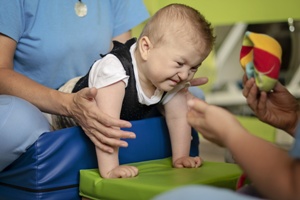 You want to do everything you can for your child. After a cerebral palsy diagnosis, that begins with understanding the type of cerebral palsy your child has. Here, we explain ataxic cerebral palsy for parents and others who love a child who is newly diagnosed with this condition.
You want to do everything you can for your child. After a cerebral palsy diagnosis, that begins with understanding the type of cerebral palsy your child has. Here, we explain ataxic cerebral palsy for parents and others who love a child who is newly diagnosed with this condition.
Ataxic Cerebral Palsy Causes and Symptoms
There are several causes of ataxic cerebral palsy (CP) in children. Sometimes, it is the result of a birth injury. When the cerebellum is damaged during delivery because of head trauma or oxygen deprivation, ataxic CP may result.
The cerebellum regulates balance and coordination. When this part of the brain is injured, a child may exhibit symptoms of ataxic cerebral palsy, such as:
- Walking with their feet spread apart
- Unsteadiness when walking
- Trouble bringing their hands together
- Trouble grasping objects
- Speech problems
- Vision problems
- Hearing problems
- Eating difficulties
- Behavior problems
- Learning problems
- Seizures
- Tremors or shakiness in their arms
- Difficulty with repeated motions
Any of these symptoms should be promptly reported to your baby’s doctor.
Diagnosing Ataxic Cerebral Palsy
Once a doctor knows that your child is exhibiting symptoms of ataxic CP, he or she will conduct the necessary exams and tests to diagnose the condition. There isn’t one definitive test that will confirm ataxic cerebral palsy. Instead, a variety of diagnostic tools may be used, including:
- Clinical assessment using tests such as the Romberg Test and the Moro reflex test
- A detailed report of labor and delivery of your child
- Brain MRI, CT Scan or ultrasound
- EEG to test electrical activity in the brain
- EMG to check for muscle weakness
- Tests to rule out other medical conditions with similar symptoms
Often, a doctor will not consider an ataxic CP diagnosis until a child is at least 18 months old, but a diagnosis is almost always made by age three. Once ataxic CP is confirmed, the medical team will develop a treatment plan.
Treatment of Ataxic Cerebral Palsy
This condition is unique in every child, and as a result, each child will have different needs. Currently, there is no cure for ataxic cerebral palsy, but some of the available treatment options include:
- Occupational therapy. Occupational therapy can focus on daily tasks such as playing, eating, hand-eye coordination, and other activities to help increase the child’s independence.
- Physical therapy. Physical therapy can help a child with ataxic CP with walking and other movement problems to increase his or her mobility.
- Speech and language therapy. A speech and language pathologist can work with a child on the child’s particular issues to help improve the child’s communication.
- First Steps and special education. From birth to age three, a child may benefit from Kentucky’s early intervention program known as First Steps. An individualized family service plan will be developed to specify what services your child will receive. After age three, your child may be eligible for special education if ataxic CP interferes with his progress in the general education curriculum.
- Medications. Medicines such as muscle relaxants and anti-anxiety medication may ease some of the symptoms of ataxic CP.
- Assistive medical devices. Assistive devices such as walkers, wheelchairs, or leg braces may help your child.
Even with treatment, however, ataxic CP will impact your child’s day-to-day life.
How to Help Your Child After an Ataxic Cerebral Palsy Diagnosis
Other than First Steps and special education, your child’s treatments will cost money. If your child’s ataxic CP was caused by a birth injury due to negligence during delivery, your child might have the legal right to bring a lawsuit for damages. Among other things, the damages should include compensation for all of your child’s past and future ataxic cerebral palsy medical treatments and therapies. Damages may also include compensation for past and future lost income, physical pain, emotional suffering, and other losses.
To learn more about how to protect your child’s right to compensation, please start a live chat with us or call us any time—24/7/365. The, let’s meet for a free, no-obligation consultation so that you have all of the information you need to make an informed decision about protecting your child’s rights.
Related Links: